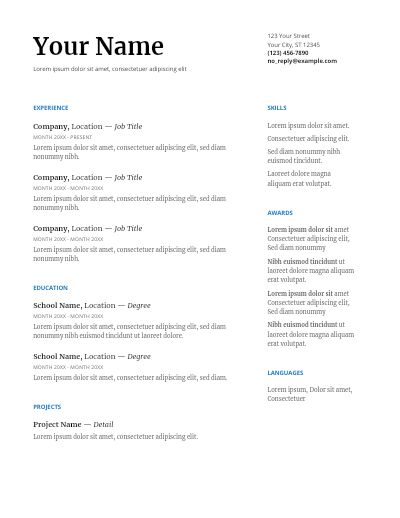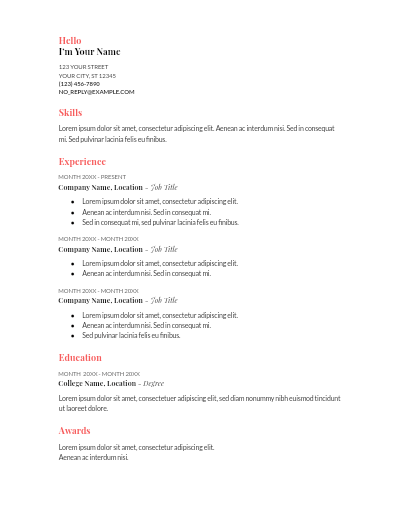Deciding how many bullet points to use per job on your resume is a crucial layout decision. Too many are often redundant, can lead a potential employer to think you can’t share your ideas concisely, and too few may not completely highlight your skills, accomplishments, and experience.
In addition, effective bullet points with a strong action verb are essential in the work experience section, the skills section, and the resume summary.
How many bullet points should you put under each job on your resume?
In most cases, 3-4 bullet points will do the trick. Include strong action verbs and quantifiable results to make the most of each bullet.
Because we’re often asked, “How many bullet points per job should I put on my resume?” we reached out to career counselors, HR experts, and leading resume writers for their advice. Utilizing bullet points under the job title or skills section is crucial when creating an effective resume to launch your job search.
Why Are Bullets Important In A Great Resume?
To Break Up Blocks of Text
Long paragraphs slow down a potential employer as they scan numerous resumes for a job opening. One way to improve readability is by adding bullet points that break up the text and make it easy to skim through. Utilizing sub-bullet points can also be effective when showcasing specific projects and accomplishments.
To Put Emphasis on Important Skills
You want the recruiter to take note of the essential skills you have to give you a chance at the job. Therefore, you can display your skills and qualifications in bullet points to make them easy to spot. Doing that also ensures that whoever is reading your resume does not miss the critical sections of the resume.
To Improve The Resume Format
The format of your resume is one of the most important things to consider when designing your resume. A recruiter will disregard any resume that is not well organized and easy to skim. You want to ensure your resume has an appealing format that is neat and quick to read. Leveraging bullet points in critical sections, including under skills and jobs, is essential.
7 Ways to Determine How Many Bullet Points Per Job on a Resume
We believe these tips below can be helpful to anyone regardless of experience level. These bullet point considerations can also be practical when writing a cover letter or introductory email.
1. Do Not Overuse or Underuse Bullets
A resume is a summary of your qualifications and your work experience. According to the required standards, it should be between one and two pages, and you should only include the most relevant information on your resume.
Another critical reason to make it brief is that there will always be many applicants for the same role you applied for, and the recruiter aims to spend as little time as possible on each resume. Too many bullets bore the reader, while too few make your resume too shallow.
Johannes, the Founder & CEO of Financer.com, had this to say:
Generally, resumes reciprocate perfectly well when crafted in a precise and systematic format. The candidates applying must understand and respect the time of HR professionals. The HRs aren’t just waiting for your resume but have many other tasks.
Resumes must consist of every detail concerning your potential skills and experiences. However, there’s a catch; resumes shall not cover stories about your experiences. Just adding 3-5 bullet points about the insights and your learning is enough to get you judged.
Andrei Kurtuy, Co-Founder & CCO at a leading resume builder, Novorésumé added:
As the founder of a resume-building website, I believe each job/role on your resume should be explained in 3-6 bullet points. Writing just one bullet point per job role might not cover your entire job responsibilities and would not add any value to your application.
However, writing more than six bullet points would be too elaborate and take up more space on your resume, thus refraining from noting other skills and roles. Having more than six points can also lead to the employer losing interest in your profile due to too many details.
The sweet spot for the number of bullet points per job on a resume is between 4 and 6. This allows an individual to provide sufficient information on their primary tasks for the role. Conversely, 1-2 bullet points are too few as insufficient detail can be portrayed, whereas above eight is when things get excessive.
2. Maximize The Bullets on The Most Relevant Roles
Your work history will carry different weights and relevance to the job you are applying for. Some jobs are very relevant, while others are barely relevant to the new role. You should use the significance of the experience to determine where to add more bullets and where to use the minimum number of bullets.
Also, the most recent jobs should have more detail than jobs you did many years ago or when you started your career. Use bullets to explain your roles, core competencies, and achievements in the job experience most relevant to your desired job. That way, the employer will see the value you can bring to their company by looking at what you have accomplished in past roles.
Jon Hill, the CEO and Chairman of the Texas-based executive renewable energy search firm, The Energists, shared the following about relevant roles and bullets:
As a broad range, I would say you want 2-6 bullet points under each position. To get a bit more specific, I recommend having 4-6 bullet points under the 1-2 jobs that are the most directly relevant to the position or company you’re applying for and only put 2-3 bullet points under those roles more tangentially related.
This helps emphasize the jobs most likely to add value for the person reviewing your resume and how this experience has prepared you for said role.”
3. Highlight Specific Achievements in Each Bullet Point
Some people list their tasks and duties in previous jobs without a deeper dive into how they accomplished those tasks and the impact on the company. If you want the recruiter to recognize your value, you must show them how valuable you were to your past employers.
Use the bullet points to give specific details about your roles, responsibilities, and achievements relevant to the position, per the job description you hope to get. As much as you should not provide stories in bullet points, you should also not give shallow or vague statements in that sector.
Dan Shortridge, a resume writer with Results Resume and former hiring manager, shared the following with MatchBuilt.
A good rule of thumb is 3-5 good, focused bullet points per job or role. They shouldn’t be mere recitations of duties or tasks but highlight your specific achievements. If a coworker could use the same bullet points, your resume is too vague and generalized. Delete or rewrite anything that doesn’t support your career story and show how you would bring value to your new job.
Your results should quantify your accomplishments and include numbers whenever possible. I prefer this format: Action Verb – Specific Result – Context – Method. For example: “Managed 20% increase in customer engagement on Instagram and LinkedIn over ten months with organic content strategy emphasizing video.
4. Your Bullet Points Should Start With Action Verbs
Action verbs describe what you did in a specific role. Starting every bullet point with an action verb, like “trained new employee,” when describing your achievements in a previous position is essential. Use a variety of exciting verbs, and do not repeat a single verb throughout the bullet points. Use verbs that show your involvement in the role and explain how your actions helped the company grow. As you’ll note in the bullet point examples below, bullets do not need to be complete sentences.
Jennifer Hill, the author of the book ‘Stop Hoping, Start Hunting,’ a Job Seekers Guide to Finding a Dream Job, added the following about using action verbs:
It is essential to begin each bullet with an action verb and follow up with how you increased Productivity, Efficiency, or Performance or what I call PEP.
The resume-building and executive consulting website founder also added some insight to this point and even gave some examples:
You should try to maximize your content within 3-6 bullet points and concisely communicate your responsibilities and tasks during the previous jobs. I would suggest beginning your sentence by using an action word to describe your impact and then mentioning how you achieved this goal.
Moreover, ensure each bullet point is just one line, and you have used numbers to show how significant the impact was.
Here’s an example of what a job in the resume should cover:
UNILEVER LIMITED, Human Resource Intern
Project: “Developing a Year to Date recruitment dashboard.”
- Collected and filtered recruitment data for over 100 employees to visualize and analyze recruitment trends
- Identified four bottlenecks in the recruitment process and visualized 27 different trends by creating an annual recruitment dashboard on PowerBI
- Enhanced persona mapping by visualizing open roles on PowerBI according to 3 categories.
5. Use Numbers To Quantify The Results
Using bullet points with quantifiable results is more potent than vague statements. The best way to maximize the content of each bullet point without giving excessive information is by including relevant numbers.
Giving specific and quantifiable results in your resume may set you apart from every other candidate. It also provides credibility to your soft skills and qualifications because you can demonstrate how you have used them in the past and their impact.
Here are a few examples from the responses we got from experts in the field:
- Utilized inner joins in amalgamating multiple SQL queries into one, which resulted in a 42% reduction in database query time.
- Reliably coordinated bi-weekly standup meetings to guide junior developers, leading to 76 hours being saved throughout the project.
Jon Hill also added some examples:
First, start every bullet point with an action verb. This makes the statements more powerful, meaning they’re likelier to stick out to someone reading the resume.
Second, include specific accomplishments wherever possible. If it’s appropriate for your role, include financial figures like sales or revenue increases, growth of client portfolios, etc.
An example of those two tips in practice:
Weak bullet point:
“I managed multiple high-value client accounts, leading to revenue increases for the company.”
Strong bullet point:
“Achieved $3.4 million revenue increase for the company through successful management of 9 client accounts, each with a value of $500,000 or more.”
6. List In Order of Importance
Having the most critical points at the top of your bullet list is essential to stand out to employers. The same way you should list the most recent job at the top of your experiences is the same way you should list the responsibilities under the role.
Focus on relevant points to the job so your resume can attract the recruiter’s attention. If you include the specific details and results of a role in the first bullet point, the employer will want to read the rest of the points to see how valuable you can be to their company. For example, if the job entails training, make sure your first bullets discuss how you trained new employees at your job.
Starting your list with irrelevant information will kill the recruiter’s interest, and they might not even read the rest of the resume to see whether you fit the job. Ensure you grab the recruiter’s attention immediately after their eyes land on the bullet points by ensuring you have relevant and essential information at the top.
7. Keep It Simple
Relevant bullet points are meant to capitalize on your skills and key accomplishments that match the job description. Therefore, presenting these skills is crucial to getting you what you want. You should keep the bullet format as simple as possible to avoid stealing the shine away from your qualifications.
You do not want the recruiter to focus on the decorative bullets you have on your resume and miss out on the essential details. Try to use hyphens, basic circles, or squares when listing items on your resume for a clean and neat look.
Resume Examples With Bullet Points
Writing a resume with effective bullet points from scratch is time-consuming. You can avoid the headache completely with the help of these Google doc templates. Perfect for creating a great entry-level resume, they’re super easy to use and have been utilized by thousands of job seekers.
Remember all the tips above regarding the proper number of bullet points per job when using the resume templates below from google docs. Also, use relevant keywords throughout the resume content of the education, experience, and summary sections for a complete ATS-compliant resume.
To use the templates below, click on the image to view the Google doc resume. From there, you can save the resume as any type of document you’d like (Google Docs, Word, etc.). You can also save it as another Google doc to begin editing another draft.
To quickly find these examples and resumes on Google Docs, launch the Google Docs app (create an account if you haven’t already). Then, click “Template Gallery” from the home page and scroll down until you find the resume templates. Pick a template and start editing.
You can easily add or replace any section you wish and quickly add your address and pertinent career history. If you’re unhappy about the skills section being so high up, replace it with a professional summary or a career objective.
1. Google Doc “Spearmint” Example Template With Bullet Points
2. Google Doc “Serif” Example Template With Bullet Points
3. Google Doc “Coral” Example Template With Bullet Points
4. Google Doc “Swiss” Example Template With Bullet Points
5. Google Doc “Modern Writer” Example Template With Bullet Points
How Many Bullets Per Job on Resume Recap
Using resume bullets to break up the text and emphasize the relevant experience, relevant accomplishments, and key skills is critical. However, the effectiveness of the bullet point depends on how detailed and specific the information is.
On functional resumes, bullet points are typically found in important sections such as the professional experience area and education section. It’s recommended to have 3-6 bullets under each role with more focus on functions that are relevant to the job.
It is also crucial to start your bullet points with action verbs and quantify what you did in your previous jobs.








